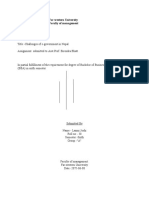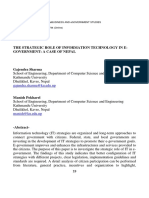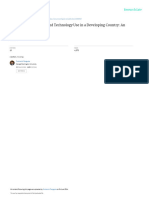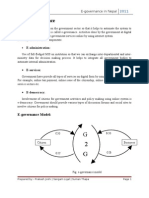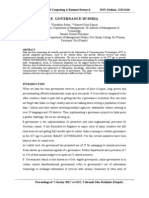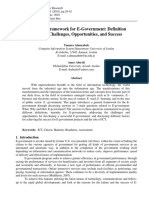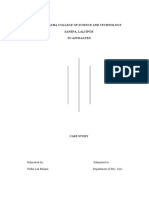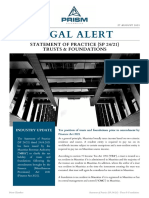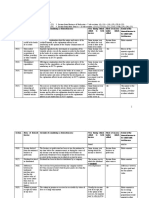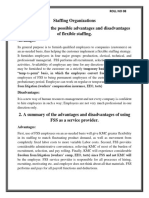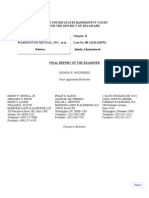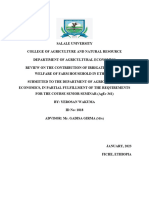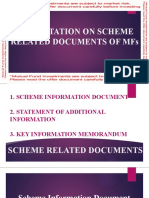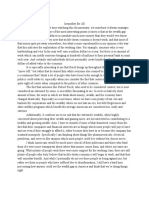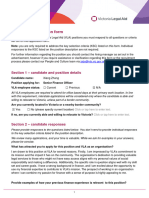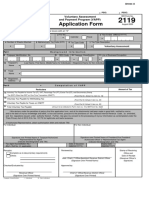Government Developmentin Developing
Uploaded by
Bidya Sagar LekhiGovernment Developmentin Developing
Uploaded by
Bidya Sagar LekhiSee discussions, stats, and author profiles for this publication at: https://www.researchgate.
net/publication/338986635
E-Government Development in Developing Countries: Emerging challenges, ICT
policy and Legal Issues in Nepal
Article · February 2020
CITATIONS READS
4 1,959
1 author:
Shailendra Giri
Personnel Training Academy (PTA) and Local Development Training Academy (LDATA) Ministry of Federal Affairs and General Administration, Nepal
25 PUBLICATIONS 262 CITATIONS
SEE PROFILE
All content following this page was uploaded by Shailendra Giri on 02 February 2020.
The user has requested enhancement of the downloaded file.
Pramana Research Journal ISSN NO: 2249-2976
E-Government Development in Developing Countries:
Emerging challenges, ICT policy and Legal Issues in Nepal
SHAILENDRA GIRI
Executive Director, Personnel Training Academy-PTA
Ministry of Federal Affairs and General Administration, Kathmandu Nepal
Abstract:
Within very short span of time, developing countries are showing their pace in the development
of the e-Government which has changed the peoples' day to day life style though they have been
lagging behind in e-government use as compared to developed countries. E-government
development in developing countries have the potential to build better relationships between
government and the public by making interaction with citizens smoother, easier and more
efficient. Nepal is facing numerous emerging challenges while e-government development and
government activities as well as service delivery. The aim of this paper is trying to explore the e-
government development in developing countries and to analyses the emerging challenges of e-
government, ICT policy and legal issues in Nepal. The content analysis method is used during
research. This paper concludes that Nepal is facing numerous challenges whole implementing e-
government like poor ICT infrastructure development, law and public policy, insufficient human
resources development and management, digital divide and e-literacy. Some other challenges
are political issues, inadequate human resources, lack of a legal framework, low per capita
income, little public awareness about ICT and new technology. For authentication and
regularization of the recognition, validity, integrity, and reliability; it is essential to make legal
provisions. Nepal requires a bold set of institutional reforms aimed at achieving better
governance while enforcing the rule of law. The reason of success and failure of e-government is
the lack of comprehensive regulatory framework and good coordination between regulation
implementing agencies of government. Citizens play a major role to make government success or
failure. There are not sufficient act and policy in ICT sector so different sector wise law, policy
and plan should formulate in time for regulating the e-government activities in the nation.
INTRODUCTION
E-government is defined as a system utilizing the Internet and the world-wide-web for delivering
government information and services to citizens. This system reduces the processing costs,
improves service delivery, and increases transparency and communication between a
government and its citizens [1]. E-government involves using information technology (IT), and
particularly the Internet, to enhance the delivery of government services to public, businesses,
and other government agencies and receive services from the central, province or local
Volume 9, Issue 4, 2019 1011 https://pramanaresearch.org/
Pramana Research Journal ISSN NO: 2249-2976
governments [49],[50] The e-Government provides electronic services to all sectors of
government agencies with the help of development of new technologies [47] and it is considered
as an implication of ICT in order to improve public services and strengthen support to public
policies. In general, developing countries have been lagging behind in e-government use as
compared to developed countries even though they have been facing various challenges [59]. It
can be adopted successfully if it is regulated by a legal framework and with ethical manner [21]
and the implementation of e-government is increased in the number of nations but the rate of
adoption varies from country to country.
Electronic government or e-government provides the convenience and availability of government
services and information to the public and to build better relationships between government and
the civic by making interaction with citizens smoother, easier and more efficient [50]. It
simplifies the execution of information, communication, and government services; and processes
between governmental institutions, business houses and private organizations as well [2]. It is
considered the primary tool to facilitate the access of the citizens to various services [36]. The
rapid advancement in new technologies like ICTs has undoubtedly influenced positive changes
in carrying out administrative functions in government institutions [3]. In order to meet the
global challenges in administrative management, the use of ICTs for service delivery cannot be
abandoned [4]. Which is shifting human daily life style. The continuous change in technology
and its impact on commerce and societies have shown the importance of information
management system. Many institutions are considered as successful in daily administration and
to simplify the service delivery which learned how to use the new technologies and their
functions [34].
Due to globalization, economic liberalization, neo application of IT and the emerging aspiration
of the service holder challenges are created in e-government implementation [43]. For effective
implementation of e-government service in developing countries, it is necessary to consider the
issue of humanizing and enhancing citizen trust in the e-Government system [37]. Restructuring
of Nepal into a federal state has posed more challenges to the government for implementing
policies, plan and to deliver efficient services to the general public using new technology. There
is a need of huge leap-frog to make it ultramodern technology-based service provider as smart as
of the developed countries, which is the major aspiration of the Nepalese people [17].
According to Giri and Shrestha [18] vision of 'digital Nepal' and 'paperless government' should
be our roadmap for the improvement of the public sector and e-governance should be our
national priority sectors. They further stated that the e-government master plan should be revised
to make it more holistic and implemented honestly in time. For its full implementation not only
government sector, but also the private sector and society as a whole should be prepared. In spite
of some progress in infrastructural development in ICT, development of e-government in Nepal
has been in an initial stage. Lack of optimal leadership flourished with an unstable government,
motivation, and commitment of staff, technological and geographical digital divide, ICT
infrastructure, and financial insufficiency are some of the issues under discussion that are
hindering (fostering) e-governance implementation in Nepal [19].
E-government development in developing countries like Nepal is still facing difficulties and
challenges during service delivery [11]. This paper is focuses on development of e-government
in developing countries, e-government development in Nepal, emerging challenges of e-
government, success and failure stories of e-government system and IT Policy and Legal issues
Volume 9, Issue 4, 2019 1012 https://pramanaresearch.org/
Pramana Research Journal ISSN NO: 2249-2976
in Nepal. The content analysis method is used for complete the study. Books, journals, Ph.D.
thesis, government survey reports, news-letters are used as the reference materials.
II. LITERATURE REVIEW
2. E-Government:
The United States (US) was the first country in the globe which implemented the concept of e-
government by making the first tentative steps in the early 1990s to change the entire system of
public administration throughout the use of new technologies. It's noted that US has taken first
initiatives to develop the national strategy in applying information technologies in public
administration and academia to start discussion in the early 1970s. In this context the concept to
regulate the use of information technologies in various spheres of public administration was
offered only twenty years later when in February 1993 in San Jose (California). The regards goes
to President Bill Clinton and Vice President Albert Gore for encouraging the use of new
information technologies at all levels of the federal government and national [30].
For the developing countries in Asia and the Pacific, e-governance is increasingly being
emphasized as a way for governments to strengthen good governance. If implemented
strategically e-governance can not only improve efficiency of government processes, but it can
also be a tool to empower citizens by enabling them to participate in the decision making
processes at policy level of government’s bodies [5]. The government as a service provider and
manager of e-Government system must be ensured trust so that service recipients will be
motivated to use e-Government service confidently [15]. He again said that public trust is
foundation of relationship between service provider and service recipients. So, public trust is one
of the critical factors of successes through the system adoption. The need for building trust
between the government and other stake-holders of e-government is considered a fundamental
principle in designing and developing effective e-government system [37].
According to Kumar & Best [33], e-government may improve its services; the success and
failure, therefore, depend on the size of the gap that exists between current realities and design of
the e-government project [23],; and [15] it facilitates interconnection between the government
and its agencies (G2G), government and citizen (G2C) and government and business (G2B). E-
government is imperative to maintain a trustful relationship between the government and its
constituencies [14]. The development of the internet and continuous improvement of the
management information systems, has introduced a new perspective to the public relationship
[41]. The e-Government concept is now commonly acknowledged for adoption of public service
enhancement [55] and current banking sector and e-commerce areas are depending on the
electronic environment for their operation of many years [7]; the internet usage has been
increasing electronic environment hence, these factors caused the creation of electronic
operations and services in the public institutions [12].
2.1. Development of e-government in developing countries
ICT has become part of day-to-day life in developed countries. It has the potential to become a
backbone of development in countries like Nepal. ICT is one of the fundamental building blocks
of modern societies and digital economies. While ICT might be luxury for a rich country, for a
country like Nepal, ICT is a crucial weapon to fight against poverty and thus it ensures our
survival. Instead of making only verbal commitments at workshops and seminars, politicians
Volume 9, Issue 4, 2019 1013 https://pramanaresearch.org/
Pramana Research Journal ISSN NO: 2249-2976
should make commitments on ICT implementation truly in practice to enhance the socio-
economic condition of citizens across the nation [46]. In compared to developed countries,
developing countries are lagging behind in e-government adoption and development [13]. IT
offers the opportunity for the government to better deliver information and services and to
interact with citizens, businesses, and other government stakeholders in an effective manner [19].
Developing countries are also showing their pace in the development of the ICT sector and are
showing promising results in terms of overall development [26]. The overall development of any
country is a result of ICT. It would remain far behind in any sort of development because now all
form of development is related to ICT if a country fails to pace up its ICT development along
with the world [44]. Most of the developing countries have lacking e-government capacity since
they have differences with respect to geographical adversity, infrastructure availability
throughout their territory, socio-economic standard and technology application managerial
capacity [16]. The success and failure factors of the e-government project in developing
countries are uniquely different from those in developed countries [53].
The Asia Foundation [56] states that, in Asia, there is growing recognition that e-governments
have the ability to improve government transparency by increasing accountability and reducing
opportunities for corruption. Major barriers can be met in the adoption and diffusion of e-
government services depending on the readiness of a country in terms of ICT infrastructure and
deployment [24]. An implementing e-governance in Nepal is identifying how the program’s
objectives and challenges relate to the vision and a strategy developed by the government [51]. A
common argument in most literature dealing with e-government in developing countries is the
focus on transparency and fighting with corruption. If applied effectively in developing countries
strategy can advance e-government productivity in the public sector. It's possible to implement e-
government only from the government side but needs public support and trust in government
service delivery [17].
2.2. E-Government Development in Nepal
E-governance, as an effective means of governance in Nepal, was already conceptualized with
the implementation of the first IT Policy in the year 2000 [54]. In order to understand e-
governance, there needs to understand it conceptually [48]. The use of ICT and its application by
the government for the provision of information and public services to the people need to be the
precise and globally accepted definition of e-government, which highlights both the means and
objectives of the e-government concept [20]. The processing of the country’s data started with
the establishment of the National Computer Center (NCC) in1974. The involvement of the
private sector in the area of software development started during the 1980’s. The concept of
outsourcing was already implemented during 1982’s. In the early 90’s, a large number of IT
companies emerged in the capital city, Kathmandu. E-governance in terms of its capability for
bringing about a major standard shift in the way public administration functions. A possible
means of good governance observes by the Government of Nepal [51],[63].
E-service such as e-procurement, e-banking, e-commerce or an online trader exchange, are
among the services included in G2G and G2B services. This permits transparency in bidding,
banking, and purchase process and gives the prospect to other smaller businesses, this enables
easy procurements and purchase of commodities online. Top priority sector of e-government
implementation is mentioned as e-agriculture, e-education, e-health, e-tourism, e-roads, e-vital
Volume 9, Issue 4, 2019 1014 https://pramanaresearch.org/
Pramana Research Journal ISSN NO: 2249-2976
registration, e-Sewa, e-administration, and others [57]. The government of Nepal proposed
milestones for e-government as establishing an integrated data center, starting a Database ICT
development project, making IT policy 2010, establishing an ICT center in Institute of
Engineering, Pulchowk Campus, Tribhuvan University by signing a MoU between Ministry of
Finance, Nepal and Republic of Korea [61]. Tele-center and others private ICT centers are the
very necessary medium of e-government system to provide services and information exchange
from top to down. ICT center’s network around the country, carries out ICT education,
awareness, and health programs in rural areas for the development [6].
ICT plays a vital role in daily life of individuals, institutes, offices, and government so as to
achieve their goal with minimal inputs like money, human resources, etc. [40]. This statement
intends to clarify ICT which is the unavoidable tool of e-government. One of the greatest impacts
on e-governments' development is trends and challenges [38].
With the help of telecommunication and internet, the Government of Nepal is outspreading its
services to communicate with poor people, rural and mountain regions [17]. Transformation
within the three major authorities of government may be expected, namely: political, economic,
and administrative [57]. Nepal is in the internalizing process of e-government concept with its
second version of E-government Master Plan [10], with the vision of using ICT for good
governance. The general goals for e-GMPII to transform street-level bureaucracy to screen level
bureaucracy are to:
1. Increase the efficiency of government bodies through the use of ICT.
2. Provide an easy and appropriate mechanism of sharing information between government
bodies and reduce duplication of information.
3. Promote local ICT industries.
2.3. Emerging challenges of e-government in Nepal
E-government challenges include infrastructure development, law and public policy, digital
divide and e-literacy [25]. Nepal’s government is facing numerous challenges in introducing and
implementing e-governance. These include political issues, inadequate human resources, lack of
a legal framework, little public awareness about ICT and poor ICT infrastructure across the
nation, low literacy, low per capita income, lack of leadership and leadership’s commitment and
insufficient financial resources are the major constraints and the challenges of e-government
implementation in Nepal [51],[31]. There remains a challenge [35] to achieve both qualitative
and quantitative growth in motion picture and telecommunication sectors. Similarly, the task of
developing infrastructure to expand optical fiber network to all local levels and extend the use of
IT to schools, health sector and government offices for national development is another
challenge.
Tasks of extending national transmission of Nepal Television and satellite transmission of NTV
Plus amid country’s diverse geographical structure and also transmit nationally while competing
with the private sector operated television channels have added to the challenges. The task of
digital switches over from analog system of production, editing, and transmission of television
programs by 2017 through its own internal resources is a daunting challenge. Gorakhapatra,
Nepal Television and Radio Nepal that stand as national communication media need to compete
Volume 9, Issue 4, 2019 1015 https://pramanaresearch.org/
Pramana Research Journal ISSN NO: 2249-2976
with the private sector run communications media while broadcasting and publishing news and
other programs in various languages with a sense of national responsibility is a daunting task
[35]. Developing countries generally lag behind in a modern education system that can build
robust human capital. Insufficient knowledge can lead to misuse of the electronic processes
hindering the political benefits of ICT use [15].
2.4. Legal Issues
2.4.1 Review of existing policies
Policies are used to set a standard for performance. Through policy, an organization can develop
clear expectations for employees and administrators. It provides a framework for consistent
actions. First and foremost, proper policies protect the institution from non-compliance with the
law. Clear organizational guidelines allow organizational leaders to avoid overlooking any legal
imperatives which might otherwise go unnoticed. The IT policy shall be formulated to make IT
accessible to the general public and increase employment through this means, build a
knowledge-based society and establish knowledge-based industries [42].
2.4.2. Development of IT policy and creation of legal instruments
For authentication and regularization of the recognition, validity, integrity, and reliability; it is
essential to make legal provisions [42]. Nepal requires a bold set of institutional reforms aimed at
achieving better governance while enforcing the rule of law [39]. There are several legal
instruments created to develop IT sector for augmenting e-governance as IT Policy 2000, IT
Policy 2004, Electronic Transaction Act 2004, Telecommunication Policy 2004, E-governance
Master Plan, IT commitments in different plan periods, Electoral Transaction and Digital
Signature Act 2000, Copyright Act 2000, Telecommunication Act and Regulation 1997, National
Communication Policy 1992 and National Strategy Paper on ICT [32]. Policies on information
and communication in Nepal date to the Radio Act of 2014 (1957), which established the need
for radio transmitter licenses and designated the central government as the issuing authority. The
IT policy was revised in 2010. After a demand for the revised policy featuring the ICT as a
whole, the Government of Nepal devised the IT Policy 2015 again [58]. The need for a well-
defined and consistent policy and regulatory framework for addressing converged regime of
telecommunications, broadcasting, and ICT. These policies as a whole regulate all the activities
regarding the ICT in Nepal [19]
IT policy is a significant and important step in the right direction towards the developing the ICT
sector and represent the society as knowledge-based. But, however, several challenges have
beset Nepal's efforts aimed at building upon the initial momentum that it gained in the ICT
domain [42]. IT Policy was first promulgated in 2000 with the vision to place Nepal on the
global map of ICT within the next five years period. The policy had the following objectives:
a. To make IT accessible to the general public and increase employment through this means
b. To build a knowledge-based society.
c. To establish knowledge-based industries.
In 2004, new IT policy was announced with the vision to transform Nepal into a knowledge-
based society by 2015 to become fully capable of harnessing ICTs gives new envisage for the
application of ICT to achieve the goals for good governance, poverty reduction, and social as
Volume 9, Issue 4, 2019 1016 https://pramanaresearch.org/
Pramana Research Journal ISSN NO: 2249-2976
well as economic development [27]. This document is a legal basis to promote good governance
and sustainable development through the application of ICT. The latest IT Policy of 2010 has
special provisions for outsourcing and expanding the use of IT [64]. The policy has put emphasis
on information security and data protection and privacy in IT. The new policy has identified the
IT sector as a knowledge-based industry and it includes the involvement of youth in employment
generation as one of the major objectives. The policy suggests adopting a single window policy
to attract domestic and foreign direct investment in the IT sector. The other provisions included
in the policy are intellectual property rights and e- certification [28].
2.5. Success and failure stories of e-government system
The implementation of e-governance has not been largely successful in the country like Nepal.
The causes of failing to effective implementation of e-governance are digital divide, rude
administration process and other hurdles [54]. It is obligatory to make public service delivery
more effective, competitive and qualitative and service holder friendly to make government is
image clean and impartial. With it, the performance of the government would be fair and result
oriented [52]. He further said that success and failure of e-government depend not only on
bureaucrats of the country but also depends on technocrats. If the government succeeds to take
advantage of the knowledge and skill of the retired civil servants, it will be a great achievement
for the country [29]. Standardization is another key point for the execution and services of e-
Government [9]. Different sources indicate that strong political leadership is one of the important
factors for e-government success [56]. Using only one system for institutions will reduce the
costs and also enable the standardization process. The most important criteria to success in
electronic state system are to enable participation of all stakeholders by a citizen focused
approach. While some developing countries have taken initiation to transform the government
into the digital form they often fail to meet their expectations in improving their governance
system achieving expected outcomes [22]. The reason of success and failure of e-government is
the lack of comprehensive regulatory framework and good coordination between regulation
implementing agencies of government [19].
According to Heeks [22], e-government in the developing countries fails with 35% being
classified as total failures with 50% partial failures. Different economic, social and political
circumstance may have a determining effect on the realization of e-government objectives [45].
Apart from failure cases, there are several reasons for the slower adoption of ICT by public
sector institution in developing countries. The government has a responsibility to provide
leadership in developing a culture of privacy protection and security [15]. The indicators of the
result-oriented performance evaluation system should be applied at all ministries to make civil
service more result oriented, effective and responsible, through the performance contract system
[8]. He further said that e-government implementation is not a joke and without making citizens
satisfied through government activities and efficient and effective service delivery. It is clear that
the citizens play a major role to make government success or failure. It is necessary for trust on
the e-government and technology but data security is major concern in present day [62].
Volume 9, Issue 4, 2019 1017 https://pramanaresearch.org/
Pramana Research Journal ISSN NO: 2249-2976
CONCLUSION:
Nepal is facing numerous challenges whole implementing e-government like poor ICT
infrastructure development, law and public policy, insufficient human resources development
and management, digital divide and e-literacy. Some other challenges are political issues,
inadequate human resources, lack of a legal framework, low per capita income, little public
awareness about ICT and the nation. Nepal has still many problems in case of using ICT in
government and other sectors. For authentication and regularization of the recognition, validity,
integrity, and reliability; it is essential to make legal provisions. Nepal requires a bold set of
institutional reforms aimed at achieving better governance while enforcing the rule of law. There
are several legal instruments created to develop IT sector for augmenting e-governance as IT
Policy 2000, IT Policy 2004, Electronic Transaction Act 2004, Telecommunication Policy 2004,
E-governance Master Plan, IT commitments in different plan periods, Electoral Transaction and
Digital Signature Act 2000, Copyright Act 2000, Telecommunication Act and Regulation 1997
and National Communication Policy 1992. The reason of success and failure of e-government is
the lack of comprehensive regulatory framework and good coordination between regulation
implementing agencies of government. Citizens play a major role to make government success or
failure. There are not sufficient act and policy in ICT sector so different sector wise law, policy
and plan should formulate in time for regulating the e-government activities in the nation.
References:
[1] Alia, S., Omar, S. and Bassam, A.S., (2012). A cultural e-government readiness model.
Intelligent Information Management, 4, 212-216.
[2] Andreas Meier (2012 ). eDemocracy & eGovernment, Stages of a Democratic Knowledge
Society. Springer Science+Business Media. Springer Heidelberg Dordrecht London New
York (Available at online: www.springer.com)
[3] Azeez, N.A.; Abidoye, A.P.; Adesina1, A.O.; Agbele, K.K.; Venter, I.M.; &. Oyewole, A.S.
(2012). Threats to E-Government Implementation in the Civil Service: Nigeria as a Case
Study. The Pacific Journal of Science and Technology. 13(1), 349-402.
[4] Banks, D., Oxman, J., Rodgers, S. and Irish, P. (2002). Mission in Action: An Operational
Definition of E-Governmen. National Defense University: Washington DC,
[5] Bestle, L.H. (2005). “Pro-poor eGovernance in Asia and the Pacific: Making Public Service
Delivery Work Better for the Poor”, Concept Note, UNDPAPDIP Bangkok Regional
Centre.
[6] Bhattrai, M., K.(2013). Nepali: ICT and e-government scenario. High level Commission for
IT. Nepal: Kathmandu.
[7] Claessens, J., Dem, V., De Cock, D., Preneel, B., & Vandewalle, J. (2002). “On The Security
Of Today’s Online Electronic Banking Systems”, Computers & Security,21(3), 253-265.
Volume 9, Issue 4, 2019 1018 https://pramanaresearch.org/
Pramana Research Journal ISSN NO: 2249-2976
[8] Dahal, K. R. (2017). Utilization of experience civil servants. Public Service Journal,
Kathmandu:Public Service Commission, Nepal. 1(1). Pp. 38-47.
[9] Dawes, S. S. (2008). “The Evolution and Continuing Challenges of E‐governance”, Public
Administration Review, 68(1), 86-102.
[10] eGMP (2015). E-Government Master Plan, 2015-2019. Kathmandu: Government of Nepal.
[11] Elkadi Hatem (2013) Success and failure factors for e-government projects: A case from
Egypt. Egyptian Informatics Journal. Vol 14, Issue 2, pp 165-173.
[12] Eryılmaz, B. (2008). Kamu Yönetimi Düşünceler Yapılar Fonksiyonlar, Okutman Yayıncılık,
Ankara.
[13] Furuholt, B., & Wahid, F. (2008). E-government challenges and the role of political
leadership in Indonesia: the case of Sragen. Proceeding of the 41st Hawaii International
Conference on System Science. IEEE, Waikoloa, HI, USA
[14] Ghimire, N. (2017). Use of ICT in scholarship management in civil service: Present status
and the way forward. Journal of Personnel Training Academy. Lalitpur: PTA, Nepal. 5(1),1,
pp. 60-63
[15] Ghimire, T. B. (2014). Data protection law and policy factor impact on public trust in e-
government system in Nepal. Journal of Personnel Training Academy. Lalitpur: PTA,
Nepal. 2(1), 2. pp 26-36.
[16] Ghimire, T.B. (2011). A Ph.D. dissertation on regulatory policy factor impact on cultivation
of public trust in e-government system in Nepal, submitted to Seoul National University.
Information Technology Policy Program. (Available at Library.snsu.ac.kr)
[17] Giri, S. & Shakya, S.(2018). ICT tools and service delivery: A case of Nepalese civil
service. Proceedings of Science Globe International Conference, 10th June, Bengaluru,
India.
[18] Giri, S. & Shrestha, R. L. (2018). Reform of civil service of Nepal with e-government
practice. Journal of Personnel Training Academy. 6(1)6. Pp. 22-36
[19] Giri, S. and Shakya, S.(2018). ICT and service delivery mechanisms in civil service of
Nepal. International Journal of Computer Science and Mobile Computing, 7, 4, April- 2018,
pp. 47-52 (Available Online at www.ijcsmc.com )
[20] Global-E government readiness report (2004). Towards access for opportunity. New York:
Department of Economic and Social affairs.
[21] Hai, S.B. (2005). Making e-governance happen–a practitioner’s perspective. In: Yong,
James, S. L. (Ed.) E-government in Asia: Enabling Public Service Innovation in the 21st
Century. Singapore: Times Editions-Marshall Cavendish. Pp. 446-470.
[22] Heeks, R. & S. Bailur, (2007). Analysing e-government research: perspectives,
philosophies, methods and practices”, Government Information Quarterly. 24 , 2, 243-265
[23] Heeks, R. (2003). Most e-government for-Development Projects Fail: How Can Risks be
reduced? Institute for Development Policy and Management. University of Manchester,
Harold Hankins Building, Precinct Centre, Manchester, M13 9GH, UK. (Aavailable at:
http://idpm.man.ac.uk/publications/wp/igov/index.shtml)
[24] Ibrahim, A., Alghamdi, R.G. & Giselle, R. (2011). E-Government readiness assessment for
government organizations in developing countries. Computer and Information Science, 4, 3-
17.
Volume 9, Issue 4, 2019 1019 https://pramanaresearch.org/
Pramana Research Journal ISSN NO: 2249-2976
[25] Information for Development Program (infoDev),( 2002). The e-government handbook for
developing countries. International Journal of Computer Science and Mobile Computing, 4,
11, Pp. 48-56 (Retrieved from http://www.infodev.org. )
[26] International Telecommunication Union (2015). ICT facts and figures 2015. Retrieved from
https://www.itu.int/en/ITU-D/Statistics/Documents/facts/ ICTFactsFigures2015.pdf
[27] IT policy (2004). Kathmandu: Government of Nepal, Nepal. (Available at:
www.nitc.gov.np)
[28] IT policy (2010). Kathmandu: Government of Nepal, Nepal (Available at: www.nitc.gov.np)
[29] Jha, S. K. (2017) Experience of servce. Public Service Journal. Kathmandu: Public Servie
Commission, Nepal. 1(1), pp. 56-57.
[30] Kassen, M. (2015). E-Government in the United States: The Federal Model of
Implementation. In: Understanding Systems of e-Government (pp.27-43). Rowman &
Littlefield: New York, NY
[31] Kharel, P. (2012). Strategic Framework for the Implementation of e-Government: Nepal
Case. Ph.D. thesis. Dhulikhel: Kathmandu University, Nepal.
[32] Kim, Y.S. (2007). E-Governance Implementation Strategy in Least Developed Countries: A
Nepalese Case. Available at: http://delivery.acm.org (accessed 20 January 2016)
[33] Kumar, R. & Best, M. L. (2006). Impact and Sustainability of e-government services in
developing countries: Lessons learned from Tamil Nadu, India. Information Society. 22, I-
12. (Available at: http://citeseerx.ist.psu.edu/ viewdoc/download?
doi=10.1.1.162.1637&rep=rep1&type=pdf)
[34] Laudon, K. C., & Laudon, J. P. (2012). Management information systems: Managing the
digital firm (12th ed.). Prentice Hall. (Available at: http://dinus.ac.id
/repository/docs/ajar/MIS_KC_Laudon.pdf)
[35] MoF (2017). Economic Survey,Government of Nepal. Singhadurbar: Ministry of Finance.
Kathmandu, Nepal.
[36] Mohammad, A. S., B. Sriram (2015) . Major challenges in developing a successful e-
government: A review on the Sultanate of Oman. Journal of King Saud University-
Computer and Information Science. Vol 27, Issue 2, pp 230-235
[37] Mousavi, S.A., Pimenidis, E., & Jahankhani, H. (2008). Cultivating trust – an electronic-
government development model of addressing the need of developing countries.
International Journal of Electronic Security and Digital Forensics, 1(3), pp.233-248
[38] Nathaly, S., Fabio, M.(2012). Analysis of Electronic Government Switzerland. Department
of Informatics. Fribourg: University of Friebourg.
[39] NPC (2017). 14th plan document. Kathmandu: National planning commission, Nepal.
[40] Ochieng, D. M., & Gichoya, D. M. (2013). Demystifying ICT-enabled services in local
authorities in Kenya: What is the foundation for online transaction service system?
Communications in Information Science and Management Engineering, 3(12), pp. 586-594
[41] Palvia, S. C. J., & Sharma, S. S. (2007). “E-government and e-governance:
definitions/domain framework and status around the world”, In International Conference
on E-governance (pp. 1-12).
[42] Pande, R.N. (2017). E-governance and cyber security in Nepal. Journal of Personnel
Training Academy. Lalitpur: PTA, Nepal. 5(1)5. Pp. 30-38.
Volume 9, Issue 4, 2019 1020 https://pramanaresearch.org/
Pramana Research Journal ISSN NO: 2249-2976
[43] Pandey, G.K. (2016). Geographical information system in development and planning
Nepal. Swashasan the journal or Self-Governance and Rural Development, 42, pp 18-26
[44] Park, S., Choi, D., & Hong, P. (2015). Club convergence and factors of digital divide
across countries. Technological Forecasting And Social Change, 96, 92-100. (Available at:
http://dx.doi.org/10.1016/j.techfore.2015.02.011).
[45] Pina, V. Torres, L. & Acerate, B. (2007). Are ICTs promoting government accountability?
A comparative analysis of e-governance development in 19 OCED Countries. Critical
Perspectives on Accounting, 18, 5, pp 583-602
[46] Regmi, M.(2017). Strategies for e-government in Nepal's civil service. Journal of Personnel
Training Academy. Lalitpur: PTA, Nepal. 5(1),5, 86-101.
[47] Riad, A.M., Hazem, M., El-Bakry & Gamal, H.E. (2010). A novel DSS framework for e-
government. International Journal of Computer Science, 7, 33-37.
[48] Rossel, P. and Finger, M. (2007). Conceptuling e-governance. ICEGOV Conference
proceeding, Macau, 10-12.
[49] Salhofer, P. & Ferbas, D. (2007). A pragmatic approach to the introduction of e-
government. Proceeding the 8th annual international conference on Digital government
research: Bridging disciplines & domains. Philadelphia, Pennsylvania, USA — May 20 –
23,183-189
[50] Sharma, G., Bao, X. & Qian, W. (2012). Public attitude, service delivery and bureaucratic
reform in e-government: A conceptual framework. Information Technology Journal, 11:
1544-1552
[51] Sharma, K. (2014). Relevancy of the reform of public service commission on the context of
the restructuring of the state. Nijamati Sewa Darpan. Kathmandu: Public service
commission, Nepal.
[52] Sharma, R.(2015). Government of Nepal. Quarterly Bulletin. Kathmandu: Ministry of
General Administration, Nepal.
[53] Shin, S. Song, H. & Kang, M. (2008). Implementing e-government in developing countries:
Its unique and common success factors, Paper Presented at the Annual Meeting of the
APSA, Annual Meeting. Hynes Convention Caenter, Boston. Available online at:
www.allacademic.com Accessed at: 9TH February 2016.
[54] Sirendi, R. (2017).The challenges of e-governance implementation in Nepal. Un published
thesis. Tallinn University of Technology: School of Information Technologies.
[55] Sobacı, M.Z., & Yıldız, M. (2012). E-Devlet Kamu Yönetimi ve Teknoloji İlişkisinde
....Güncel Gelişmeler, Nobel Akademik Yayıncılık, Ankara. 10. Sprague Jr, R. H. (1995).
Electronic document management: Challenges and opportunities for information systems
managers. MIS Quarterly, 19(1), 29-49.
[56] The Asia Foundation (2007). Improving governance and reducing corruption through e-
government. http://www.asiafoundation.org/CCT/egovernment.html accessed 11 January
2017.
[57] UNDP (2004). Benefits of e-government. United Nation Development Program. A United
Nations Publication
[58] Wallsten, S.J. (1999). An empirical analysis of competition, privatization and regulation in
Africa and Latin America. Policy Research Working Paper no. 2136,1. The World Bank
Development Research Group Regulation and Competition Policy: Policy research
Dessemination center.
Volume 9, Issue 4, 2019 1021 https://pramanaresearch.org/
Pramana Research Journal ISSN NO: 2249-2976
[59] West, D.M.(2006). Global e-government. Report, Center for Public Policy. Brown
University, Rhode Island. http://www.insidepolitics.org./egovt06int.pdf. Accessed 3rd
January 2016.
[60] World Bank 2016. E-government Tool Kit for Developing Countries. World Bank:
Washington DC.
[61] Shrestha, P. S. (2017). E-Government and its challenges in Nepal. Journal of Personnel
Training Academy. Lalitpur: PTA, Nepal. 5(1),5 , 124-136
[62] Giri, Shailendra (2019). Cloud Computing and Data Security Challenges: A Nepal Case.
International Journal of Engineering Trends and Technology, 67(3), 146-150.
[63] Giri, Shailendra (2019). Obstacles of Civil Service in Public Service Delivery in Nepal: E-
Governance for Good Governance. International Journal of Computer Science and Mobile
Computing, Vol.8 Issue.3, pg. 269-274
[64] Giri, Shailendra, (2019). Cyber Crime, Cyber threat, Cyber Security Strategies and Cyber
Law in Nepal. Pramana Research Journal. Volume 9, Issue 3, pp 662-672. Available at:
https://pramanaresearch.org
Volume 9, Issue 4, 2019 1022 https://pramanaresearch.org/
View publication stats
You might also like
- Digital Nepal: Opportunities and Challenges: International Journal of Research PublicationsNo ratings yetDigital Nepal: Opportunities and Challenges: International Journal of Research Publications16 pages
- Expanding Practices of E-Governance System in The Contemporary WorldNo ratings yetExpanding Practices of E-Governance System in The Contemporary World21 pages
- Case Study Report On E-Government Development in Nepal Compared To IndiaNo ratings yetCase Study Report On E-Government Development in Nepal Compared To India58 pages
- E-Government, E-Participation and Challenging Issues: A Case StudyNo ratings yetE-Government, E-Participation and Challenging Issues: A Case Study13 pages
- EGovernance in Nepal ProgressChallengesNo ratings yetEGovernance in Nepal ProgressChallenges23 pages
- The Strategic Role of Information Technology in E-Government: A Case of NepalNo ratings yetThe Strategic Role of Information Technology in E-Government: A Case of Nepal21 pages
- E-Government Implementation in Nepal: A ChallengesNo ratings yetE-Government Implementation in Nepal: A Challenges11 pages
- Acme Engineering College, Sitapaila, Kathmandu, Nepal: Purbanchal UniversityNo ratings yetAcme Engineering College, Sitapaila, Kathmandu, Nepal: Purbanchal University13 pages
- View of E-Government Challenges in Developing Countries - Development of Iraqi E-GovernmentNo ratings yetView of E-Government Challenges in Developing Countries - Development of Iraqi E-Government16 pages
- Experiences of E-Government Development Implementation in Developing Countries Challenges and SolutionsNo ratings yetExperiences of E-Government Development Implementation in Developing Countries Challenges and Solutions16 pages
- Technology Transfer-Adoption & E-Government Implementation Issues-Week4No ratings yetTechnology Transfer-Adoption & E-Government Implementation Issues-Week411 pages
- Organizational Culture and Technology Use in A DevNo ratings yetOrganizational Culture and Technology Use in A Dev17 pages
- Review of Data Mining and Data Warehousing Implementation in E-GovernanceNo ratings yetReview of Data Mining and Data Warehousing Implementation in E-Governance11 pages
- E-Governance in Nepal: The Challenges in The Implementation of The National Identity Card in NepalNo ratings yetE-Governance in Nepal: The Challenges in The Implementation of The National Identity Card in Nepal21 pages
- E-Governance in India: Prospects & ChallengesNo ratings yetE-Governance in India: Prospects & Challenges20 pages
- E-Governance in India: International Journal of Computing & Business Research ISSN (Online) : 2229-6166No ratings yetE-Governance in India: International Journal of Computing & Business Research ISSN (Online) : 2229-616612 pages
- Subhash Bhatnagar - E-Government - From Vision To Implementation - A Practical Guide With Case Studies-SAGE Publications Pvt. LTD (2004)0% (1)Subhash Bhatnagar - E-Government - From Vision To Implementation - A Practical Guide With Case Studies-SAGE Publications Pvt. LTD (2004)204 pages
- E-Governance-Emerging Dimension in India: Dr. Anuradha TyagiNo ratings yetE-Governance-Emerging Dimension in India: Dr. Anuradha Tyagi6 pages
- E Governance of Bangladesh Present Scenario Expectation Ultimate Target and RecommendationNo ratings yetE Governance of Bangladesh Present Scenario Expectation Ultimate Target and Recommendation20 pages
- A General Framework For E-Government: Definition Maturity Challenges, Opportunities, and SuccessNo ratings yetA General Framework For E-Government: Definition Maturity Challenges, Opportunities, and Success14 pages
- International Transaction Journal of Engineering, Management, & Applied Sciences & TechnologiesNo ratings yetInternational Transaction Journal of Engineering, Management, & Applied Sciences & Technologies13 pages
- E-Government in Pakistan: Challenges & OpportunitiesNo ratings yetE-Government in Pakistan: Challenges & Opportunities10 pages
- The Barriers of E-Government Success An PDFNo ratings yetThe Barriers of E-Government Success An PDF18 pages
- E-Government and E-Governance - Swedish Case Studies With Focus On The Local LevelNo ratings yetE-Government and E-Governance - Swedish Case Studies With Focus On The Local Level33 pages
- E-Government Final Formated Submitted To ICICT 2015 PDFNo ratings yetE-Government Final Formated Submitted To ICICT 2015 PDF4 pages
- Chapter1 - IntroductiontoE Governance 02No ratings yetChapter1 - IntroductiontoE Governance 021 page
- Engineerinng Management Presentation Group-Bidya and TeamNo ratings yetEngineerinng Management Presentation Group-Bidya and Team13 pages
- Legal Alert: Statement of Practice (SP 24/21) Trusts & FoundationsNo ratings yetLegal Alert: Statement of Practice (SP 24/21) Trusts & Foundations3 pages
- Washington Mutual (WMI) - Attachments/Exhibits To The Final Report of The Examiner (Part 1/10)No ratings yetWashington Mutual (WMI) - Attachments/Exhibits To The Final Report of The Examiner (Part 1/10)427 pages
- Bulgaria Sofia: Urban Agriculture in An Economy in TransitionNo ratings yetBulgaria Sofia: Urban Agriculture in An Economy in Transition18 pages
- Investment & Portfolio MGT - Module 2 - Investment in Stocks - PDFNo ratings yetInvestment & Portfolio MGT - Module 2 - Investment in Stocks - PDF22 pages
- Green White Minimalist Modern Real Estate Presentation - 20240507 - 170047 - 0000No ratings yetGreen White Minimalist Modern Real Estate Presentation - 20240507 - 170047 - 000012 pages
- Askari Commercail Bank: University of Management & Technology-SBENo ratings yetAskari Commercail Bank: University of Management & Technology-SBE46 pages
- Experiential Exercise 4A: Performing A Financial Ratio Analysis For Walt Disney CompanyNo ratings yetExperiential Exercise 4A: Performing A Financial Ratio Analysis For Walt Disney Company9 pages
- Prepared For: Dr. Zaid Bakht, Professor, MBA Program North South UniversityNo ratings yetPrepared For: Dr. Zaid Bakht, Professor, MBA Program North South University11 pages
- Candidate Application Form - Senior Finance OfficerNo ratings yetCandidate Application Form - Senior Finance Officer2 pages








